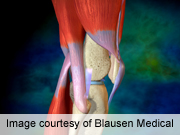
FRIDAY, March 22 (HealthDay News) — Getting back to work after knee-replacement surgery is a big concern for people contemplating the procedure. Now, a new study shows that most people return to work after a total knee replacement — even those with physically demanding jobs.
The research, scheduled for presentation Thursday at the annual meeting of the American Academy of Orthopaedic Surgeons in Chicago, shows that 98 percent of people who undergo total knee replacements are able to go back to work afterward.
“We were very surprised by the results,” said study author and orthopedic surgeon Dr. Adolph Lombardi, president of Joint Implant Surgeons, an orthopedic surgery practice in Columbus, Ohio, which specializes in knee and hip replacements. “We’re doing an operation that is helping patients to stay in their work environment.”
Total knee replacement, also called total knee arthroplasty, is typically recommended when a knee joint is severely damaged by arthritis, said Dr. Fabio Orozco, a joint-replacement surgeon at the Rothman Institute and an assistant professor of orthopedics at Jefferson Medical College in Philadelphia. Orozco was not involved with the research.
Genetics, age, sports injuries and other causes can play a role in the need for knee replacement. The two-hour surgery involves an incision in the knee, cleaning out damaged bone and cartilage, realigning and balancing the joint space, and replacing it with an artificial joint made of special metals and plastics. The aim is to relieve pain and improve function and mobility.
The study involved nearly 700 knee replacement patients from five medical centers who were questioned by an independent survey company.
Sixty-one percent of the study patients were women, and 75 percent were employed during the three months before their knee surgery. They ranged in age from 18 to 60 years old, and the average was 54.
“All of the previous literature was on older patients, so we tried to recruit younger patients,” Lombardi said.
Their work environments before knee surgery ranged from sedentary (desk-type work) to highly physical labor.
Although 98 percent of the study participants returned to work, 89 percent returned to the same work they performed prior to their knee surgery. Lombardi said the return-to-work rate for the more labor-intensive categories was especially notable. Ninety-seven percent were able to return to very heavy work, and 98 percent went back to heavy work. Ninety-five percent headed back to sedentary jobs, 91 percent returned to light jobs and 100 percent returned to medium-intensity work.
Men were significantly more likely than women to return to work, the study found.
“These studies show there is a cost savings to society,” said Dr. John Tongue, president of the American Academy of Orthopaedic Surgeons. “People are getting back to work. They can pay taxes instead of being on disability.”
Each year, more than 650,000 people in the United States undergo knee replacement, according to the academy. That’s twice the number performed a decade ago, Tongue said.
“Thirty years ago, people were scared to death of having this operation, but it is so effective that more people are getting it now,” he said. “Their general health depends on it, and many are choosing to have it sooner than before. They are fighting for their mobility.”
Orozco said half of his knee-replacement patients are under age 50.
“We are now reaching a population that is younger and actively working. Most have very arthritic knees and expect to go back to work,” Orozco said. Better implant materials that support more weight, improved surgical techniques that spare muscle, and better post-surgery patient care plans — including pain management and physical therapy — have increased the popularity of knee replacement in recent years, he said.
“Now patients are back at work in a matter of weeks, compared to the past when it took months sometimes,” Orozco said.
The surgery costs about $35,000, including the implants, hospital stay and post-procedure physical therapy, and it is typically covered by insurance — but it depends on a patient’s plan, Orozco said.
After surgery, Orozco said there is no reason patients shouldn’t get back to activities they previously enjoyed, including sports.
“I recommend to my patients to return to what [they] love to do,” he said. However, he advises obese patients to consider weight loss.
Study author Lombardi said it’s rewarding to follow up with patients after their surgery.
“To see these patients with crippling arthritis in the knee be able to walk and move again — it’s amazing,” he said. “We can restore them back to a very active and pain-free lifestyle.”
Data and conclusions presented at meetings are typically considered preliminary until published in a peer-reviewed medical journal.
More information
The American Academy of Orthopaedic Surgeons has more about knee replacement.

